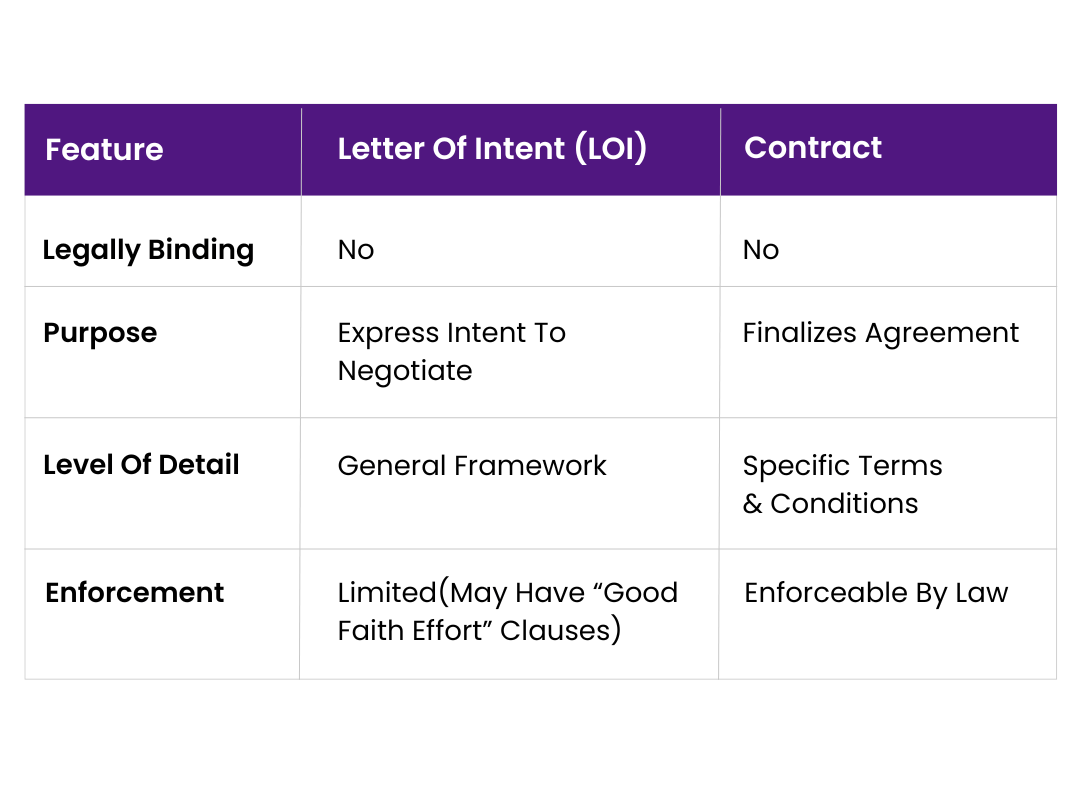The world of business thrives on agreements, both formal and informal. But before the ink dries on a final contract, there’s often a crucial preliminary step: the letter of intent (LOI).
This document serves as a bridge between initial discussions and a binding contract, outlining the key terms and establishing a good faith commitment between parties.
What is the Purpose of a Letter of Intent?
An LOI serves several critical purposes:
- Establishing Framework: It lays out the core elements of a potential agreement, including the subject matter, key terms, and desired outcomes. This provides a clear roadmap for further negotiations.
- Demonstrating Serious Intent: An LOI signifies a genuine interest in moving forward with a deal. It fosters trust and shows both parties are committed to working towards a formal contract.
- Guiding Negotiations: The LOI acts as a framework for subsequent discussions, ensuring both parties are on the same page regarding the deal’s core principles.
- Confidentiality: LOIs often incorporate non-disclosure agreements (NDAs), safeguarding sensitive information shared during negotiations.
Is a Letter of Intent Binding?
No, a letter of intent is not a legally binding contract. It expresses a shared intention to negotiate but doesn’t hold the same legal weight as a formal contract.
However, LOIs can sometimes include provisions for exclusivity or “good faith effort” clauses, encouraging both parties to prioritize reaching a final agreement.
It’s important to remember that the letter of intent meaning is one of establishing a good faith effort, not a legally enforceable obligation.
Letter of Intent vs Contract
Here’s a table summarizing the key differences between a letter of intent and a contract:

Letter of Intent Uses: When is an LOI Used?
LOIs find application in a wide range of business scenarios, including:
- Mergers and Acquisitions (M&A): An LOI outlines the basic terms of a potential merger or acquisition, paving the way for due diligence.
- Joint Ventures: An LOI establishes the groundwork for a collaborative business venture, specifying roles, responsibilities, and profit-sharing mechanisms.
- Real Estate Transactions: An LOI can be used to express interest in purchasing or leasing a property, outlining the proposed terms and timelines.
- Loan Agreements: An LOI can serve as a preliminary agreement for a loan, outlining the loan amount, interest rates, and repayment terms.
- Employment (Rare): In rare cases, an LOI might be used by a candidate to express strong interest in a company, even if there’s no open position.
How Long is a Letter of Intent?
An LOI’s length can vary depending on the complexity of the deal. They typically range from 2-5 pages, focusing on the most critical aspects of the agreement.
What is Contained in a Letter of Intent?
While the specific content can vary, a well-crafted LOI typically includes the following elements:
- Parties Involved: This section clearly identifies all parties with a stake in the potential agreement.
The level of detail can vary depending on the complexity of the deal, but it typically includes:
- Names and Titles: This specifies the full legal names of all parties involved, along with the titles of the individuals signing the LOI on behalf of their respective organizations.
- Entity Types: Identify the type of entity each party represents. This could be a corporation, limited liability company (LLC), partnership, or even an individual.
- Contact Information: Include contact details for each party, such as mailing addresses, phone numbers, and email addresses. This ensures clear communication throughout the negotiation process .
- Subject Matter: This section defines the specific business transaction or project under consideration. Be clear and concise about the nature of the agreement the LOI paves the way for.
Here are some examples depending on the scenario:
- Merger & Acquisition (M&A): Briefly describe the companies involved and the intended outcome (full merger, acquisition of a subsidiary, etc.).
- Joint Venture: Outline the purpose of the joint venture, the nature of the collaboration, and the intended areas of cooperation.
- Real Estate Transaction: Specify the property in question (address, type of property) and the intended action (purchase, lease).
- Loan Agreement: Briefly describe the purpose of the loan and the parties involved (lender and borrower).
- Key Terms: This section outlines the main points of the proposed agreement, providing a high-level overview of the critical aspects.
Here are some common elements you might find in the Key Terms:
- Financial Considerations: This could include details like purchase price, potential investment amounts, or loan terms (amount, interest rate, repayment schedule).
- Timelines: Specify key milestones and deadlines for the negotiation process or future agreement execution.
- Contingencies: Outline any conditions that must be met before the final agreement can be reached. This might involve regulatory approvals, due diligence completion, or financing secured.
- Exclusivity: This section is not always included, but it can be a crucial element in some negotiations. An exclusivity clause specifies a period during which the parties involved agree to focus negotiations solely with each other. This prevents them from pursuing similar agreements with other parties.
- Confidentiality: Non-Disclosure Agreements (NDAs) are frequently incorporated into LOIs. This section outlines the specific information considered confidential and restricts its disclosure to unauthorized third parties.
Here are the key elements typically included in a confidentiality clause:
- Confidential Information: This defines the specific types of information considered confidential under the LOI. This could include financial data, trade secrets, marketing strategies, or any other sensitive information shared during negotiations.
- Exceptions to Confidentiality: There may be certain exceptions to confidentiality, such as information that is already publicly known or independently developed by the receiving party. These exceptions should be clearly outlined in the LOI.
- Permitted Uses: The confidentiality clause may specify how the recipient can use the confidential information. This is typically limited to purposes related to the potential agreement being discussed in the LOI.
- Disclosure Limitations: This outlines who the recipient can disclose the confidential information to. It often restricts disclosure to employees, advisors, or other parties who have a need to know and are bound by similar confidentiality obligations.
- Term of Confidentiality: The confidentiality clause will specify the duration for which the information must be kept confidential. This period may extend beyond the termination of the LOI itself.
- Remedies for Breach: The LOI may outline the consequences of a breach of the confidentiality clause. This could include injunctive relief (court order to stop the disclosure) or monetary damages.
- Next Steps: This section defines the process for moving forward after the LOI is signed.
It typically includes:
- Next Actions: Outline the specific actions required by each party to progress towards a final agreement. This might involve tasks like due diligence, drafting specific terms, or conducting market research.
- Deadlines: Establish clear deadlines for completing these next steps, ensuring a timely negotiation process.
- Drafting the Contract: This might specify who will take the lead in drafting the formal contract and when that process is expected to begin. In some cases, the LOI may even designate a third-party drafter to ensure neutrality.
By understanding these key components and their functionalities, you can effectively interpret and participate in the creation of a well-drafted Letter of Intent.
Additional Considerations for a Strong Letter of Intent
- Clarity and Conciseness: The LOI should be clear, concise, and easy to understand, avoiding legal jargon whenever possible.
- Professional Representation: Consider consulting with legal counsel to ensure the LOI accurately reflects your interests and protects your rights.
- Negotiation Tool: The LOI serves as a foundation for negotiation, so be prepared to discuss and refine the terms as you move towards a final contract.
By understanding the letter of intent meaning and its role in the business landscape, you can leverage this tool effectively to navigate complex transactions.




